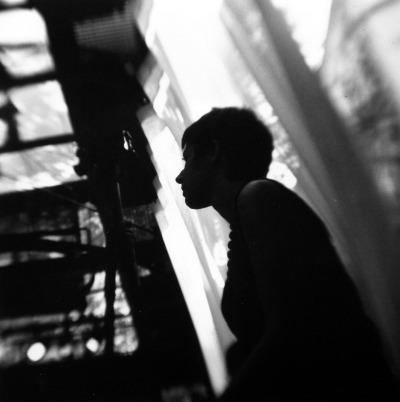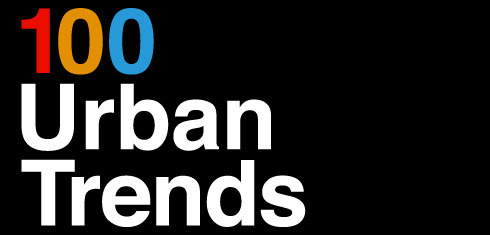#urban development
[In Tumblr dashboard, click to embiggen video]
Shit, this is astonishing. Redrow, a luxury apartment builder, have made this creepy, completely dystopic, half-American Psycho advert for the new London they’re currently metastasizing all over the city. Its protagonist lives in a world of almost continual night, with the hungry eyes and dead affect of an Ayn Rand wet dream: his world is constituted of chrome, glass, a palette of white-to-taupe, a spatter-pattern rug and one book, a single book, on graphic design. ‘Luxury’ is so often a code for this – double-glazed, polished steel, hermetically sealed in the back of a cab. Our man does not have conversations, but stares out at the city from the fifteenth floor (he does a lot of staring). The concept of conversation is alien to him, though he is shown having a screaming argument; as you see from his inventoried shelves, he has a passion for objects and this is how he treats women, as well.
Flat-toned, void affect, social cancer in a suit: a model for London living. Here’s a curious honesty about it all: houses in the suburbs are marketed still for the smiling happy family, all oak tables and smiling coffee mornings (in zone 4, the dog never even barks, let alone bites). In the central zones, having been cleared of many of their inconveniences (families, communities, *life*), now deadboxes are marketed to the single (wannabe singular) sub-Thatcherite dweeb who manages his violence only on a balance sheet, who wants to take life, pin it, and crush it behind plate glass. Let us burn it down.
This is amazing. There needs to be a word for the kind of text that deconstructs itself, that contains its own negation so nakedly on the surface.
“They say nothing comes easy - but if it was easy, it wouldn’t feel so good. [Now I have to tell myself it feels good. It feels good. I am a valid human being]
*Cutaway to a shot of the cut-glass tumbler of whiskey he drinks each morning before work*
"To look over the city that could have swallowed you whole [ / that swallowed your soul], and say, ‘I did this’, [I allowed myself to be swallowed by dreams of achievement & accumulation that were in no way individual, however much I doth protest] and stand with the world at your feet [still so distant from me.]”
The comments on Vimeo are great:- Does this remind anyone else of American Psycho?
- 100% No
- COSMOPOLIS PSYCHO.
Followed by “Sorry, comments have been disabled by the owner of this video.”

Sky Lines - Midtown Manhattan, New York City by Andreas Komodromos

It’s been a few since I added some books. I was on vacation and then getting adjusted back to work.
Starting back up with one I’m currently reading,
“Radical Suburbs: Experimental Living on the Fringes of the American City” by Amanda Kolson Hurley
Are the suburbs really that white? Did you know that in the last few years, after DECADES of stagnation, American Cities suburbs have grown more diverse than the inner cities? Did you know that as of late most immigrants coming to this country skip the city all together for the suburbs?
Amanda Hurley tackles the history and out of date assumptions revolving around American Suburbs. So far it’s been a rather interesting read. Rather short if I’m being honest but packed full of information.
Writers. We. LOVE.
by: Zoe V. Speas, The Angel Orensanz Foundation for the Arts.
Christine Mclaren doesn’t identify herself as a blogger. But you certainly wouldn’t be able to tell it from her work as the resident writer for the BMW Guggenheim Lab.

She’s the brains behind an exciting Lab series entitled 100 Urban Trends, an extension of concepts and ideas developed through the Lab’s discussions in Berlin, Mumbai, and New York.
Richard Armstrong, Director of the Solomon R. Guggenheim Museum and Foundation commented on the focus of the Lab.
“Integral to these glossaries is the concept of cities as hubs for ideas, and how the Lab has captured some of the prevailing thoughts citizens and experts alike have about their cities,“ said Armstrong.
The discoveries of the Lab will culminate in an exhibition entitled Participatory City: 100 Trends from the BMW Guggenheim Lab. It opens at the Guggenheim Museum on October 11, 2013 and runs until January 5, 2014. 
But more about this Writer. We. LOVE.
Meet Christine Mclaren.

Visit her website at http://christinemclaren.com/about/.
She describes herself as "a small town Canadian girl at heart”, but Mclaren has big-pictures idea about the world and the cities that comprise it. Her travels have taken her across the globe, from “tucked away villages in the foothills of the Austrian Alps to urban jungles of Vancouver, New York, Berlin, and Mexico City.” In her free time, she plays the saxophone for the Carnival Band(a non-profit organization dedicated to using music to empower the community) and as a result, owns an alarming about of wacky miniature top hats.

Awesome, right?
As if you’re not already impressed, her bio on christinemclaren.com claims that she speaks German and Spanish and claims that, if necessity called for it, she might be able to order a coffee, burger, or a beer in French. Unfortunately when I spoke to her in our phone interview on Friday, I failed to put this to the test.
But when speaking to Christine Mclaren, you don’t tend to question the authority of what she’s telling you.
Look at her background.
She’s committed her life’s work to journalism, with a focus on the intersection between urban development and environmental/social issues. Currently based out of Vancouver, Mclaren has written for publications such as Spacing, Metropolis, andMonocle, as well as many important print, television, and online news hubs internationally.
“I’m a fan of participatory journalism,” says Mclaren, “living in the place that you are writing about. It requires you to open yourself up and be honest about your place in the world.”
As a new blogger for the BMW Lab, Mclaren was forced to explore a new medium of news reporting. Her approach to the 100 Urban Trends involved shaping her writing to suit the needs of the blog, which became “less about form and more about content.”

Mclaren embraced the fundamental differences between the Lab and her previous work in journalism. She was particularly affected by how personal the process of blogging became.
“Your persona is attached to the writing. You are the blog. You can’t hide behind someone else’s narrative.”
Her focus upon listening to and partaking in the BMW Guggenheim LAB programs allowed her to communicate the developing ideas and concepts to the public. She composed blog posts that illustrated the overarching general themes of the Lab’s discussions. Mclaren’s intent, she explained, was “to let people make the link to the Lab themselves.”
Mclaren’s next projects will continue her investigation of environmental sustainability, liveability, affordability and solutions to the problems of building “good cities.” She shares the BMW Guggenheim Lab’s belief in the city as a vehicle of change and preservation for the future, and hopes to return to New York City in October as the Guggenheim exhibit, Participatory City, launches into full-swing.
For more information about Participatory City and the BMW Guggenheim Lab - visit http://www.bmwguggenheimlab.org/



